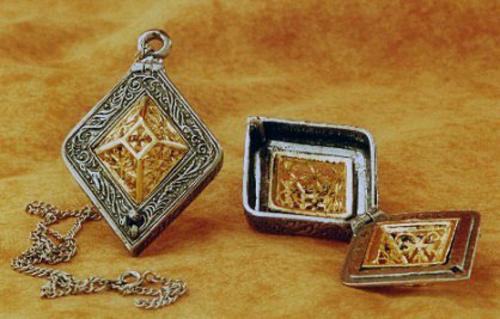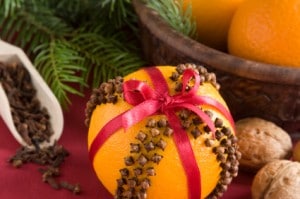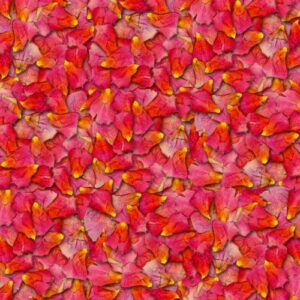Pomanders

The English word “pomander” comes from the French “pomme d’ambre”, meaning “apple of amber” or “ball of ambergris” and means:-
- a mixture of aromatic substances enclosed in a perforated bag or box and used to scent clothes and linens or formerly carried as a guard against infection; also : a clove-studded orange or apple used for the same purpose.
- a box or hollow fruit-shaped ball for holding pomander.

From the middle ages right up to the 1700s, pomanders were carried, held to the nose, suspended on chains or girdles or hung in rooms to ward off bad smells, freshen clothes and make the wearer smell nice. It was also believed that these sweet smelling herbs and spices could ward off infectious diseases and protect the wearer from illness. A pomander was a perfumed ball of some kind:-
- An orange studded with cloves and rolled in spices
- A lozenge or aromatic ball of substances like resin, gum, wax or dirt mixed with musk, rose petals, herbs and spices
- A perforated case of petals, herbs and spices
The word “pomander” could refer to the scented ball or the container which was usually carried a perforated metal case, usually gold or silver, which could be attached to belts, girdles, clothing and jewellery. Pomanders were a popular accessory in Tudor and Elizabethan times. Elizabeth I was said to carry a pomander scented with Damask Rose, Benzoin and Ambergris, and a few appear in the lists of New Year’s gifts to the Queen.
 Orange Pomander Recipe
Orange Pomander Recipe
You can make a very simple pomander to hang in a room or wardrobe by studding an orange with cloves and rolling it in spices. Here is a simple recipe:-
Ingredients
- 1 orange
- Cloves (about 25g)
- Ribbon
- Masking tape
- Cinnamon (can use orris root powder too but it is a common allergenic)
- Pins
- Greaseproof paper
- A c*cktail stick
- Paper bag or tissue paper
Method
- Knead the orange gently in your hands to soften the skin.
- Apply the tape onto the orange so that the orane is divided into 4 equal parts.
- Use the c*cktail stick to pierce the skin of the orange and poke the cloves in – space them slightly apart as the orange will shrink as it dries.
- Sprinkle the cinnamon (and the orris root if using) onto the greaseproof paper and roll the orange in the spice.
- Place the orange in the paper bag or wrap in tissue paper and leave in a warm place, like an airing cupboard, for a few weeks until the orange is hard and dry.
- Remove the tape and replace with the ribbon, tying a decorative bow.
- Hang in your wardrobe or place in a room and enjoy the fragrance.
Recipes for Pomanders to Go in Pomander Cases
If you have bought a metal pomander case, like our replica one, you may want to make yourself a lozenge/table or ball of some kind, so here are some ideas:-
 Rose Petals
Rose Petals
Simply fill your pomander case with rose petals sprinkled with rose oil.
Pomander Ball
Take 3 drams of labdanum, one dram of wood Aloes, 2 and 1/2 drams of ambergris; a dram and a half of nutmeg and of storax calamite. Confect all together with Rose-water, and make a ball” – posted by Roberta at http://www.florilegium.org/files/PERSONAL/perfumes-msg.text
Nostradamus Pomander Lozenges
In 1552, Nostradamus published instructions for making pomander lozenges or aromatic balls. Here are the ingredients he used:-
- Labdanum gum ‘as obtained from goats beards and sheeps bellies in the fortunate lands of Arabia
- Gum Storax
- Benzoin
- Rose troches
- Violet root powder (i.e. orris root)
- Musk
- Amber (Ambergris)
- Rose petals
(from http://arabesquearomas.com/writings.html#AromaticPomander – thanks, Kirsten!)
Scented Beeswax Ornaments
- 1 lb Beeswax
- Essential Oils–1/2 oz (15ml)
- Molds (can use candy molds or beeswax molds)
- Ribbon for hanging
Melt beeswax in a double boiler or in the microwave, on low heat. Spray molds with vegetable oil, cut the ribbon or cord, make a loop and dip ends in wax. Stir essential oils into melted wax and pour into molds (a small funnel helps) Add the waxed ribbon to the top of each mold. Let them set at room temperature. When hardened enough to pull away from the sides of the molds, they can be removed and decorated with sprigs, spices, lace or beads. Store in a cool place. (Recipe By Deborah Sexton from http://hubpages.com/hub/Making-Aromatherapy-Ornaments)
Pomander Beads
I’ve found a great recipe for pomander beads from the Weald and Downland Open Air Museum. You can download their PDF at http://www.openairclassroom.org.uk/images/images%20history/Apothecary%20Workshop%20Pomander%20Beads%20Recipe.pdf
Other Recipes
Original recipes from 1573 and 1609 can be found at The Painted Face website along with a great adapted pomander recipe.
Our Pomander
The pomander we have for sale on our shop is a replica of a 1580 German pomander which is found in the Victoria and Albert Museum. It is rhomboid in shape, with a pierced, gold-plated tetrahedral cage and is perfect for dressing up your Tudor costume or as an accessory to any outfit. It is made by Steve Millingham who made the state chains, cutlery and accessories for “The Tudors” and who has also supplied pieces of jewellery for “The Other Boleyn Girl”, the West End production of “A Man For All Seasons”, Hampton Court Palace, The Tower of London, English Heritage, the National Trust and various museums.
You can find our pomander at https://www.theanneboleynfiles.com/products-page/elizabeth-i-jewelry/elizabethan-jewelry/
Claire,What a great Idea for the Christmas Holiday ,as a gift to friend or family thouh you may have to explain what it is to some.My childern no what thay are and why they were used. When my gown arives I will put my order in to the AB site for RENN Season.
I made pomanders with my young grandsons this Christmas 2014, for them to give as family gifts, oranges studded with cloves. As I did with my sons when they were young. They are charming, and their history adds to the gift.
I have made pomanders for many years and sm fortunate to have a very ancient jar of real labdanum. Both are featured in my The Essential Oils Book. I decorate my pomanders and they become a family heirloom fit for a King … Or Queen!
CKD